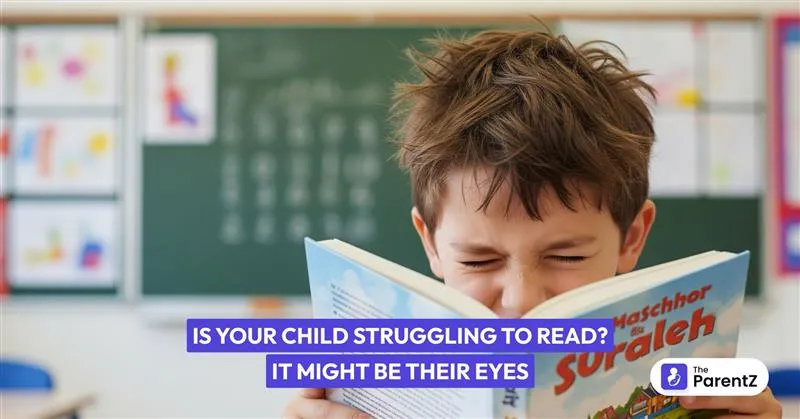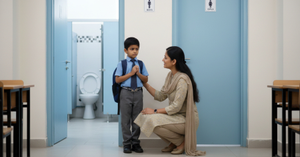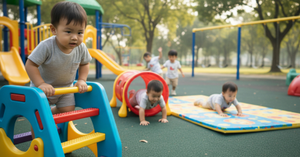Is your child having a hard time reading? Maybe they avoid books, lose their place on the page, or get frustrated when it’s time for homework. Before you assume it’s just a lack of interest or a learning issue, consider this: the problem might be with their eyes. Many parents are surprised to learn how often vision problems are the hidden reason behind reading struggles.
Why Reading Can Be a Challenge
Reading isn’t just about knowing letters and words. It’s a complex process that relies heavily on the eyes and the brain working together. If your child’s eyes aren’t focusing, tracking, or teaming up properly, reading can feel exhausting or confusing. Sometimes, kids themselves don’t even realize their vision is the problem; they just know reading is hard.
Why Vision Problems Are Often Missed
Many parents are surprised to learn that a child can pass a basic school vision screening and still have significant eye issues that affect reading. Standard screenings usually only check for distance vision, not for how well the eyes work together, track across a page, or focus up close. Problems like convergence insufficiency, eye tracking issues, or visual processing disorders often go undetected until a comprehensive eye exam is done by an optometrist or pediatric ophthalmologist.
Vision Issues Can Look Like Other Learning Problems
Vision-related reading struggles are sometimes mistaken for ADHD or dyslexia. Children with undiagnosed vision problems might seem inattentive, fidgety, or easily distracted during reading tasks. They may reverse letters, struggle with handwriting, or avoid homework (symptoms that overlap with other learning difficulties). It is important not to jump to conclusions about attention or learning disorders until vision has been thoroughly checked.
Signs Your Child Might Be Struggling Because of Their Eyes
Here are some common clues that vision, not just reading ability, could be the issue:
- Squinting, rubbing their eyes, or complaining of headaches during or after reading
- Losing their place, skipping lines, or re-reading the same line
- Moving their head instead of their eyes when following text
- Holding books very close or far away
- Avoiding reading or showing frustration and fatigue quickly
- Complaints of words looking blurry, moving, or doubling on the page
- Trouble remembering what they just read
If you notice these signs, it’s time to look beyond just reading practice.
The Eye Issues That Can Make Reading Hard
Several vision problems can make reading a real struggle for kids:
1. Refractive Errors
- Nearsightedness (Myopia): Distant objects (like the board at school) look blurry, but close-up reading is usually fine.
- Farsightedness (Hyperopia): Close-up work is tiring or blurry, making reading uncomfortable.
- Astigmatism: Blurred or distorted vision at any distance, making words look fuzzy or wavy.
2. Binocular Vision Disorders
- Convergence Insufficiency: The eyes don’t work together well up close, causing double vision or eye strain when reading.
- Amblyopia (Lazy Eye): One eye is weaker, so the brain favors the stronger eye, affecting depth perception and focus.
- Strabismus (Crossed or wandering eyes): Eyes are misaligned, leading to double vision or trouble focusing.
3. Eye Tracking and Focusing Problems
- Poor tracking: Difficulty moving eyes smoothly across a line of text, leading to skipped words or lines.
- Accommodative insufficiency: Trouble keeping the eyes focused on close work for long periods, causing fatigue and blurry vision.
4. Visual Processing Disorders
- The brain struggles to make sense of what the eyes see, causing problems with comprehension, memory, or spatial awareness.
How Vision Problems Impact Confidence and Behavior
When reading feels like a constant struggle, it does not just affect grades. Children may lose confidence, become frustrated, or develop a dislike for school and books. Some may act out in class or withdraw from group activities because they feel embarrassed or overwhelmed by their reading challenges. Addressing vision problems early can help prevent these negative feelings and set your child up for success in and out of the classroom.
How These Issues Affect Your Child
When a child’s eyes aren’t working smoothly, reading becomes a chore. They may:
- Spend most of their energy just trying to decode words, leaving little brainpower for understanding or remembering what they read.
- Get tired or frustrated quickly, leading to avoidance or negative feelings about reading and school.
- Appear to have attention issues when, really, their eyes are just working overtime to keep up.
Vision problems can even be mistaken for learning disabilities or behavioral concerns. That’s why it’s so important to consider vision as a possible root cause.
The Role of Vision Therapy
For certain eye issues, such as convergence insufficiency, tracking problems, or visual processing disorders, vision therapy can be a game-changer. Vision therapy is similar to physical therapy for the eyes and brain. It uses exercises and activities, often guided by a specialist, to strengthen the visual skills needed for reading and learning. Not all children need vision therapy, but for those who do, it can dramatically improve reading fluency, comprehension, and confidence.
What You Can Do as a Parent
1. Watch for Signs
Pay attention to how your child behaves when reading or doing homework. Don’t ignore frequent complaints of headaches, tiredness, or “funny-looking” words.
2. Get a Comprehensive Eye Exam
A basic vision screening at school isn’t enough. Ask for a full eye exam with an optometrist or ophthalmologist, including tests for eye tracking, focusing, and how well the eyes work together, not just how well your child sees the eye chart.
3. Address the Problem Early
If a vision problem is found, follow your eye doctor’s advice. This might mean glasses, vision therapy, or other treatments. Early intervention often makes a huge difference in your child’s confidence and success.
4. Support at Home and School
- Encourage regular breaks during reading or homework (the 20-20-20 rule).
- Make reading a stress-free, positive experience.
- Let teachers know about any diagnosed vision issues so they can offer support in the classroom.
When to Seek Professional Help
If your child is struggling with reading, do not wait for things to improve on their own. Take action if:
- Your child is reading below grade level or avoids reading altogether.
- You notice frequent headaches, eye rubbing, or complaints of blurry or double vision.
- They lose their place, skip lines, or use a finger to track words
- Teachers mention attention or behavioral issues that seem to show up mostly during reading or close work.
A comprehensive eye exam can reveal hidden vision issues and open the door to effective solutions.
Conclusion
Remember, about 80% of what children learn in school comes through their eyes. Undetected vision problems can hold them back, not just in reading, but in every subject. If your child is struggling to read, don’t wait. An eye exam could be the key to unlocking their potential and helping them enjoy learning again.








Be the first one to comment on this story.